#Nagasaki tour
Text
Just imagine your husband excitedly pulling you in the direction of a clothing rental store on your group tour around the Nagasaki Lantern Festival. You try to tell him to slow down but his tugging doesn't relent, causing you to look back at his coworkers in distress only to see their smug faces telling you all you need to know.
'Just go, we'll wait for you guys right here'
Giving you the greenlight, you let your husband pull you towards the store. Looking around you find rows upon rows of traditional chinese clothing, many with intricate designs and some in different colors. What you don't see however is your husband missing from your side, it seems he already knew what he was looking for since before you can even try to find him, he reappears by your side with a staff member ushering you to a changing room.
It turned out your husband wanted to wear matching hanfus with you. As well as wanting to make sure you looked as pretty as possible, he even paid for a hair and makeup stylist for you. Though the only thing you could think about was how your poor friends were most likely still standing around outside, wondering why it's taking you both so long to put on a few clothes.
It took a while to be fully done, actually scratched that it actually took half an hour just for the hair and makeup. While you agree that you looked very pretty, the guilt of leaving your group still hasn't left since the start. Well, nothing you can do about it now. Finally done with your transformation, you thank the cosmetologist for her work and she blushes at your compliment, softly telling you that it was easier to do because you were already pretty so she just had to elevate it. You laugh at her flattery before thanking her with a bow as well as waving at the staff on your way to the register. You had an inkling that your husband already paid for but wanting to make sure, you still ask the cashier. After getting the reassurance you needed, you walk out timidly to the street.
Looking around and finding no one, you sigh at your predicament since you expected your husband to be outside waiting for you. Quickly deciding that standing around wouldn't be the best option, you start walking down the stalls lined at the sides of the street. You didn't really notice how beautiful it was, the lanterns adorned above you in different shapes and sizes. Walking across a bridge above a sea of lanterns floating on the water, it's all so beautiful. The faint sound of drums ahead accompanied by a performance by acrobats and lion dancers. You could honestly stay in this moment for longer than you should, the tranquility is a far cry from your daily life. But that doesn't make you want it more than you want to spend the festival with your friends. If anything, it makes you want to spend this time with your loved ones. Wishing your husband were here with you to enjoy the scenery together and maybe take pictures, you continue your journey to find your group.
Unbeknownst to the exchange happening behind you, a rogue husband with an outfit matching yours, in tears while covering his mouth to stop a sniffle from disturbing your moment. He went looking for you when he didn't see you anywhere near the store after he went to buy some snacks for you, only to find you on the bridge. Illuminated by the few lanterns above you and looking down upon the water below, it looked like a scene from a drama that both of you watched. Truly embodying the image of a royal lady in ancient times, waiting for someone to whisk you away to a land of fantasy. Your husband couldn't stop the tears from falling at the prospect of being able to marry someone as great as you, someone he found prettier than any flower on earth. Though it wasn't efficient in his search for you, he stopped to watch you while trying to silence his cries. So much so that he definitely forgot to call out your name to get you to stop your search.
While he was doing that, your husband didn't notice his friends watching behind him. All wearing exasperated looks on their face as the scene before them unfolds. A grown man crying at a woman leaning on the railing of a bridge, looking down at the river before leaving. While the man still stood there crying, making no move to reach out to the woman who walked in the direction of a more crowded area. Which means that this friend group is going to be dealing with a lot more than what they signed up for.
ATSUMU <3333, BOKUTO <33, NISHINOYA <3, Kuroo (listen, this emotional loser loves you so much), KITA, Suga, Thomas <3, HINATA, Kageyama, Yamaguchi, OSAMU
#「★ It's showtime! ★」#haikyu x female reader#haikyu x reader#haikyuu drabbles#haikyuu fluff#atsumu fluff#atsumu x reader#hinata fluff#hinata x reader#osamu fluff#osamu x reader#nishinoya fluff#nishinoya x reader#kita fluff#kita x reader#kuroo tetsuro x reader#kuroo fluff#suga fluff#suga x reader#adriah thomas fluff#adriah thomas x reader#kageyama fluff#kageyama x reader#yamaguchi x reader#yamaguchi fluff#AAAAAAAAAAAA#happy lunar new year :)#Listen this was supposed to be a short imagine but my hand slipped#I want to add all the boys bc like c'mon they'd cry for you whether it be inside or not#but I restrained myself
299 notes
·
View notes
Note
Do you have a travel blog/page on instagram documenting your travels in Japan, where we can see your experience, specially that you go to lots of concerts, and it might be helpful to plan a full travel around that? What do you do other than seeing the concerts, and do you have a list of cool trusted places?
I have a personal Instagram account on which I share local and travel highlights irregularly, but I don't even specify where most of those things were, so good luck using that to guide your trip...
That being said, if you want any tips for some locations, I can help with anything other than restaurants, so feel free to ask!
So far, I visited the following Japanese areas:
Kumamoto, Nagasaki, Fukuoka, Hiroshima, Itsukushima, Kouchi, Kyoto, Osaka, Nara, Nagoya, Shizuoka, Tokyo/Kawasaki/Yokohama, Yokosuka, Kanazawa, Nagano, Sendai and Sapporo.
Had/have plans for Tottori, Wakayama, Utsunomiya, Hita and more. I guess that the main area that I never visited where Dir en grey tours is Niigata.
17 notes
·
View notes
Text



For @todayintokyo, who likes Nagasaki seaside but doesn’t want to see fish ;) A delicious rice flour bread roll for breakfast on a short boat tour. We went to see this island, which is officially named Hashima but commonly known as Gunkanjima (Battleship Island) because, well, look at it!
Hashima is now a ghost town, but it was settled as an offshore mining facility in the late 1880s and abandoned upon the depletion of coal in the 1970s. It is a super eerie place to visit, and entry/tours are strictly regulated both because of rough sea conditions and because the buildings are in such a state of disrepair. We visited two days after the very serious Typhoon 14, so we were unable to go ashore this time, but I should dig up my pictures from 2010......
78 notes
·
View notes
Text
2023.12.01 Design Your Fantastic Future (DYFF) radio
Sota: The next letter is from a listener from Nagasaki, Natsun.
"This is my first time sending a letter and here is an episode of mine that relates to holding hands."
"Before this I never had a bias until I discovered FANTASTICS this year. And I went to a concert for the first time in my life, which was FANTA's."
Sota: Wow, I'm really happy to hear that, thank you!
"Thanks to that concert, I fell head over heels with Sota and my head has been full with Sota ever since."
Sota: Thank you!
"And on the next day, my boyfriend of five years held my hand and proposed to me."
"Of course I said yes, but at the time my thoughts were just full of Sota so I said, "This isn't really the time for that."
"On another day when my thoughts finally calmed down, I asked him to propose to me once more."
Sota: Girl, now you've done it... I'm sorry I feel like I was getting in the way between you two! Your boyfriend probably got his breath knocked out when you said that first time, huh...
Sota: No, but this... Ummm, PLEASE BE HAPPY! And uhh when you're married maybe you can come to our concert again as a couple!
Sota: Ok but wouldn't that make me in an awkward position in your relationship.... I just hope it wouldn't! Is what I'm trying to say!
Sota: But I truly am happy that your first bias and concert was FANTASTIC's. We're going to start on our arena tour soon, so please come by!
#banantls#nakajima sota#fantastics from exile tribe#this episode was soo funny i listened to it a couple times 🤣🤣🤣#a lot of the letters on this episode was interesting and sota was really enjoying himself too#but this one really made him fluster djkfjslf
5 notes
·
View notes
Note
If you had to create a roster for the Einherjar (without using those already on the list) who would you pick from history?
For a more fun one let’s play which Isekai characters would you pick to be an Einherjar?
This was quite fun to do!
1. Alexander the Great, educated, a strong warrior before he was king, responsible for sacking the Persian Empire, but even when the Persian King fled, he left the coward king’s family unharmed, showing that he was also compassionate. He died young and his heirs were assassinated shortly after and the empire promptly fell apart without his guidance.
2. Genghis Khan, one of history’s most infamous leaders, conquered the Mongol Empire plus most of Asia and Europe during his reign. A strong warrior and brilliant tactician who ruled his massive army, and had so many children with various women that his descendants could form their own army today. I love the mystery that nobody knows how he died or where his body is.
3. William Wallace, famous for leading Scotland to its freedom from the English, he may have not been the one to actually do it, but his actions as a warrior and a leader set in motion to the Scots rising up against King Edwards I following his death. His death was tragic, being betrayed and then executed in horrible ways and having his severed body parts displayed around England.
4. Miyamoto Musashi, a ronin samurai who killed his first person at age 13. He traveled alone with no affiliations to train his skills with a sword, which resulted in nito ichi-ryu, better known as kensai, battling with two swords. His most well-known fight was against Sasaki Kojiro, which he won, but then retired to train others with swords and retired with an undefeated record of 61 duels.
5. Spartacus, warrior turned slave turned gladiator turned rebellion leader, courageous but compassionate, a ruthless warrior who offered his enemies both mercy and respect, and led an army of rebels against their oppressors, the Roman Empire.
6. Achilles, who led the Greek army against Troy, killing Hector at the gates, a proud and strong warrior and leader, but he needs to make sure to wear iron boots that are impenetrable as everyone knows his weak spot.
7. Ching Shih, a female pirate who commanded 300 ships and was able to go toe-to-toe with the Chinese Imperial Navy. If you disobeyed you were immediately executed, but the same went for if her men raped captives, she had a no tolerance policy. She ended up getting to retire with all her wealth after the Imperial Government offered both her and her crew amnesty after they were defeated under the agreement that they would stop.
8. ‘Mad Jack’ Churchill, a British solider in WWII that charged into combat with weapons that were not common for the time, such as a sword and long bow. He was disappointed the war ended with the bombings of Hiroshima and Nagasaki, as he wanted to keep fighting. He once stormed a German held down in Italy with just one other man and captured a mortar position and 42 men with just his sword, long bow and his bagpipes.
9. Amanirenas, one eyed ancient queen of Kush, now modern day Sudan, who fought back against the Roman Empire, after the death of Cleopatra, when they decided to try to expand past Egypt, so viciously that Rome and Augustus were quick declare peace between the two empires after they couldn’t win due to the unbearable heat and the pissed off queen. A fierce tactician who used supposedly used war elephants, fed captors to her pet lion, and defaced Augustus’ statues and kept the head of one statue under the feet of the throne of Kush.
10. Lyudmila Pavlichenko, deadliest female sniper in the world; sniper for the Soviet Union in the Red Army during WWII; nicknamed Lady Death and claimed, during her time as a sniper, to have killed 309 soldiers. Became an advocate for peace and toured the world.
11. Jean-Eugene Robert-Houdin a French watchmaker, illusionist, magician and regarded as the father of the modern style of conjuring, having brought magic from something only seen at circuses or similar places like that for the poor, to something of grand entertainment for the wealthy.
12. Richard I of England, a bad king but a brilliant warrior, having spent most of his time in the Crusades, rather than running his own kingdom, or fighting against France
13. Ragnar Lothbrok, Swedish and Danish king, legendary Viking warrior leader who raid both the British Isles and the Holy Roman Empire in the 9th century
As for Isekai~
1. Ainz Ooal Gown- Overlord
2. Rimuru Tempest- That Time I got Reincarnated as a Slime
3. Canya- In the Land of Leadale
4. Azusa Aizawa- I’ve Been Killing Slimes for 300 Years and Maxed out my Level
5. Yuna- Kuma-Kuma-Kuma Bear
6. Albedo- Overlord
7. Diablo- That Time I got Reincarnated as a Slime
8. Shiraori- So I’m a Spider, So What?
9. Seiya Ryuguin- Cautious Hero: The Hero is Overpowered but Overly Cautious
10. Mamako Oosuki- Do You Love your Mom and Her Two-Hit Multi-Target Attacks?
11. Diablo- How Not to Summon a Demon Lord
12. Hajime Nagumo- Arifureta: From Commonplace to World’s Strongest
13. Teacher and Fran- Reincarnated as a Sword
19 notes
·
View notes
Text
Best Places You Must Visit in Tokyo
Introduction:
Explore japan tourist places in Tokyo, which is a very interesting combination of tradition and also modernity. Admire the famous Tokyo Tower, take a walk through the historical Asakusa district, visit the lively Shibuya Crossing, taste the delicious sushi at Tsukiji Fish Market, and relax in the peaceful Meiji Shrine. Diverse wonders for every traveler await in Tokyo.
Tokyo's Towering Beauty: The symbol of the city, the Tokyo Tower is a very tall standing building with its orange and white exterior. Climb to get the panoramic views of the city’s sprawling skyline where modernity sits with tradition and a visual feast of lights and landmarks for the eyes.
Historical Charm of Kyoto: The city of Kyoto, also a capsule of Japan’s past, has many ancient temples such as Kinkaku-ji and peaceful tea houses in areas such as Gion. Walk along the streets of history where the traditional wooden machiya houses take you back to the nostalgia of the old times.
Natural Serenity in Hakone: Hakone, a serene haven, beckons you to unwind in its revitalizing hot springs, under the watchful eye of Mount Fuji. The untouched nature, including dense forests, and quiet lakes, only adds to the tranquil ambiance, making it a very perfect getaway.
Osaka's Culinary Delights: Osaka, a foodie’s dream, comes with an exciting street food culture. From savory takoyaki to the crispy okonomiyaki, savor the local treats. Discover the famous markets such as Kuromon Ichiba, where the smell of different tastes permeates the air, a culinary tour for every tongue.
Hiroshima's Peaceful Memorial: There is a memorial park in Hiroshima, a place of remembrance that honors the past. The Atomic Bomb Dome is a symbol of the city’s history. As you walk through the park and its peaceful environment, meditate on the messages of peace and resilience to encourage reflection and comprehension.
Snowy Adventure in Sapporo: Sapporo turns into a winter fairytale, mesmerizing tourists with its famous snow festivals and ski slopes. Enjoy the wonders of the snow sculptures, sample the local food at the Sapporo Snow Festival, and ski or snowboard in the beautiful Hokkaido scenery.
Nagasaki's Rich Maritime History: Dejima Island, a former trading outpost, showcases the maritime legacy of Nagasaki. Visit the old Dutch trading post that has been preserved and learn about Nagasaki in its maritime history. The Peace Memorial deepens the meaning, considering Nagasaki’s strength and dedication to peace after the atomic bombing.
Majestic Landscapes of Nikko: Nikko promises a grandiose landscape, home to UNESCO World Heritage sites such as the Toshogu Shrine. Admire the beautiful structures and peaceful scenery. Discover Nikko’s natural landscape, including the majestic waterfalls, where the spiritual and natural elements combine to form a mystical environment in this timeless and idyllic locale.
Conclusion:
Japan presents a collage of experiences, ranging from the high-tech marvels of Akihabara to the tranquillity of the Nikko. Indeed, as the Diper Tour brings the Filipinos closer to these wonders, Japan’s charm becomes more obtainable. Celebrate the cultural convergence in the Japan tourists spots from Philippines, which serves as a great bridge between nations that share similar wonders and also memories.
#Japan tourists spots from Philippines#places to visit in Japan#Japan travel#Japan tourism#Japan tourists spots#visit Japan#holidays to Japan#Japan itinerary#Japan trip#Osaka itinerary#Tokyo itinerary
2 notes
·
View notes
Text

Ayumi Hamasaki's official site has released the logo and official dates for her upcoming 25th Anniversary Live Tour. First announced at her one-night 25th anniversary arena show, the ambitious hall tour will visit all 47 of Japan's prefectures for the first time.
Ticket information has not been announced yet; we will no doubt have more details after TeamAyu is relaunched as an app next month. The tour dates are as follows:
July 8, 2023 (Sat) Chiba: Ichihara Civic Hall
July 9, 2023 (Sun) Chiba: Ichihara Civic Hall
July 15, 2023 (Sat) Saitama: Saitama City Cultural Center
July 22, 2023 (Sat) Aomori: Link Station Hall Aomori
July 23, 2023 (Sun) Iwate: Morioka Civic Cultural Center
July 29, 2023 (Sat) Niigata: Niigata Prefectural Civic Center
August 1, 2023 (Tue) Hokkaido: Sapporo Cultural Arts Theater Hitaru
August 5, 2023 (Sat) Yamanashi: YCC Prefectural Cultural Hall
August 18, 2023 (Fri) Osaka: Festival Hall
August 19, 2023 (Sat) Osaka: Festival Hall
August 26, 2023 (Sat) Aichi: Nagoya Conference Center Century Hall
August 27, 2023 (Sun) Aichi: Nagoya Conference Center Century Hall
September 2, 2023 (Sat) Ibaraki: The Hirosawa City Hall
September 8, 2023 (Fri) Ehime: Matsuyama Civic Hall
September 9, 2023 (Sat) Kagawa: Rexxam Hall
September 17, 2023 (Sun) Yamagata: Shelter Nanyo Hall
September 18, 2023 (Mon・Public Holiday) Fukushima: Kenshin Koriyama Cultural Center
September 30, 2023 (Sat) Tochigi: Utsunomiya City Cultural Center
October 2, 2023 (Mon) Kanagawa: Kanagawa Prefectural Hall
October 8, 2023 (Sun) Hyogo: Kobe International House Kokusai Hall
October 9, 2023 (Mon・Public Holiday) Kyoto: ROHM Theater Kyoto Main Hall
October 14, 2023 (Sat) Okayama: Kurashiki Civic Hall
October 15, 2023 (Sun) Hiroshima: Hiroshima Bunka Gakuen HBG Hall
November 4, 2023 (Sat) Gunma: Beisia Cultural Hall
November 18, 2023 (Sat) Miyagi: Tokyo Electron Hall Miyagi
November 19, 2023 (Sun) Akita: Yuzawa City Cultural Center
November 24, 2023 (Fri) Fukuoka: Fukuoka Sun Palace
November 25, 2023 (Sat) Nagasaki: Nagasaki Brick Hall
December 3, 2023 (Sun) Shizuoka: Shizuoka Civic Cultural Center Large Hall
December 30, 2023 (Sat) Tokyo: To be announced soon!!
December 31, 2023 (Sun) Tokyo: To be announced soon!!
January 7, 2024 (Sun) Kagoshima: Hozan Hall (Kagoshima Prefectural Cultural Center)
January 8, 2024 (Mon・Public Holiday) Miyazaki: Miyazaki Civic Cultural Hall
January 13, 2024 (Sat) Shiga: Biwako Hall Large Hall
January 14, 2024 (Sun) Nara: Nara Centennial Hall Large Hall
January 20, 2024 (Sun) Ishikawa: Honda no Mori Hall Rescheduled 4/24 due to earthquake
January 21, 2024 (Sun) Fukui: Phoenix Plaza Rescheduled 4/23 due to earthquake
January 27, 2024 (Sat) Gifu: Toki City Cultural Plaza Sun Hall
January 28, 2024 (Sun) Mie: Yokkaichi City Cultural Hall 1st Hall
February 3, 2024 (Sat) Tokushima: Asty Tokushima
February 4, 2024 (Sun) Kochi: Kochi City Cultural Plaza CUL-PORT
February 9, 2024 (Fri) Oita: Oita Holt Hall
February 12, 2024 (Mon・Public Holiday) Yamaguchi: Shunan City Cultural Center
February 17, 2024 (Sat) Saga: Saga City Cultural Center
February 18, 2024 (Sun) Kumamoto: Kumamoto Castle Hall
February 23, 2024 (Friday) Tottori: Rika Hall, Torigin Bunka Kaikan
February 24, 2024 (Sat) Shimane: Shimane Prefectural Civic Center Large Hall
March 1, 2024 (Fri) Toyama: Aubade Hall
March 2, 2024 (Sat) Nagano: Hokuto Bunka Hall
March 9, 2024 (Sat) Wakayama: Wakayama Prefectural Cultural Center Large Hall
March 10, 2024 (Sun) Osaka: Orix Theater
March 23, 2024 (Sat) Okinawa: Okinawa Convention Center
March 24, 2024 (Sun) Okinawa: Okinawa Convention Center
April 23, 2024 (Tues) Fukui: Phoenix Plaza (rescheduled from January)
April 24, 2023 (Weds) Ishikawa: Honda no Mori Kitaden Hall (Rescheduled from January)
The only dates without a set venue are the New Year's Eve Tokyo dates, suggesting the possibility of a more traditional COUNTDOWN LIVE.
13 notes
·
View notes
Text
“Genius is no guarantee of wisdom,” says government official Lewis Strauss (Robert Downey Jr.) in Christopher Nolan’s Oppenheimer. It could be the blockbuster’s banner statement. Since the release of Nolan’s thrilling, bombastic film, the culture has been caught in the firestorm about how to explain the personality of the eloquent, esoteric J. Robert Oppenheimer and his creation of the first and only people-destroying atomic weapon to be used against civilians. Where Hollywood traffics in Oppenheimer’s ambiguity as a historical character, two small but potent nonfiction forebears ask a more pointed question: what is the responsibility of scientists to their societies?
The Day After Trinity (1981) and The Strangest Dream (2008) evacuate the mythical tropes of the tortured genius biopic that Hollywood loves to rehearse in films like The Imitation Game, Hawking, and A Beautiful Mind. Now enjoying a renaissance, the films are neither unforgiving nor hardline, but offer sharper moral clarity to the Oppenheimer dilemma, presenting a more complex (and condemning) portrait of the father of the atomic bomb: a patriot, philosopher-king, skilled public administrator, scientific collaborator with military and government, emotional naif, egotist, and polyglot.
Nolan’s story arcs towards Oppenheimer losing his naivete upon realizing that he has given humanity the power to destroy itself. Designed to wrap around each filmgoer’s own worldview and politics, the film is as politically open-ended as you might expect from a major blockbuster. In his press tour, Nolan articulated a more explicitly conservative stance that chimes both with the Great Man theory of history (another biopic favorite) and the Cold War military doctrine that justified the development and use of atomic arsenals against civilians.
“Is there a parallel universe in which it wasn’t him, but it was somebody else and that would’ve happened?” Nolan said in the New York Times. “Quite possibly. That’s the argument for diminishing his importance in history. But that’s an assumption that history is made simply by movements of society and not by individuals. It’s a very philosophical debate…. he’s still the most important man because the bomb would’ve stopped war forever. We haven’t had a world war since 1945 based on the threat of mutual assured destruction.”
That’s also the idea behind the official policy of the nuclear superpowers: deterrence. Horror, in other words, was necessary to prevent even greater horror. The very same doublethink led to Harry Truman’s honorary degree, conferred for ending the war.
How reluctant was Oppie? In Jon Else’s The Day After Trinity, a documentary originally made for public television in 1980, Oppenheimer’s collaborators deliver ambivalent, guilty testimony to a static, non-judgmental camera. Screening on the Criterion Channel, Else’s doc points to the great pleasure its subject took in being appointed the leader of the grandiose bomb project, with the cosmic job title of “Coordinator of Rapid Rupture.” The lens pans patiently across grainy, grayscale photographs that have the natural air of science fiction; the film feels more of a piece with Chris Marker’s La Jetee (1962) than a typical historical documentary. After all, Oppenheimer was not just the enabler of the weapons that could annihilate us all, but of the high-stakes hallmarks of modern spectacle itself. The awe-inspiring images of mushroom clouds over Trinity, Hiroshima, and Nagasaki are now instantly recognizable in the core visual grammar of contemporary entertainment and media. It’s hard to imagine an idea better suited to Nolan’s exalted, maximalist esthetic and his stories of obsessive male protagonists pressurized within towering patriarchal systems of power.
Oppenheimer positions the atomic bomb as the creation of a brilliant, creative personality. But The Day After Trinity revels in the administrative scale of the Los Alamos project necessary to make a mechanism to trigger, in a millionth of a second, a violent chain reaction with a flare brighter than a hundred suns. A walled city of six thousand staff, at a cost of $56 million. Seven scientific divisions: theoretical physics, experimental physics, ordinance, explosives, bomb physics, chemistry, and metallurgy. All of America’s industrial might and scientific innovation connected in this secret lab with its billions of dollars of military investment.
“Somehow Oppenheimer put this thing together. He was the conductor of this orchestra. Somehow he created this fantastic esprit. It was just the most marvelous time of their lives,” says Freeman Dyson, a rather eccentric theoretical physicist who became Oppie’s colleague at the Institute for Advanced Study in Princeton. “That was the time when the big change in his life occurred. It must have been during that time that the dream somehow got hold of him, of really producing a nuclear weapon.”
In this vision of the A-bomb narrative, Dyson posits that Oppie’s aims switched from finding out “the deep secrets of nature” to producing “a mechanism that works. It was a different problem, and he completely changed to fit the new role.” We begin to see more clearly a portrait of an outsider with a wild desire to be at the center. All the work the whiz kids were doing over the years was always designed to contribute to the war. (All the films remove Oppie’s more demonstrably radical tendencies, his belief in a world government, for instance, which he mentioned offhandedly in the New York Review of Books in 1966.)
The closest we get to Oppenheimer himself is his pale-eyed, doppelganger brother, Frank, who gives the impression of a visionary living in a purely abstract realm. He stammers a little when he speaks of the moment when he and Oppie heard on the radio of their great bomb in action. “Thank God it wasn’t a dud… thank God it worked… Up to then, I don’t think we’d really, I’d really, thought about all those flattened people.” He still seems stunned. If nothing else, Frank gives weight to the storytelling trope of scientists as hyperintelligent but flakey space cadets at a remove from the humanity of it all. “Treating humans as matter,” as Los Alamos collaborator Hans Bethe puts it appallingly. Another contributing scientist says he vomited and lay down in depression. “I remember being just ill,” he says. “Just sick.”
The doc swirls with clips accumulated from Los Alamos Scientific Laboratories, National Atomic Museum, American Institute of Physics, and Fox and NBC newsreels, while Paul Free’s authoritative narration hovers like an omniscient voice from the depths of the Cold War itself. Then, there is Oppie: a figure of stricken elegance in his rakish pork pie hat. Typical of documentaries constructed in a postmodern style, what it all means is never explicated. Ambiguity presides over clarity.
Most directive is Dyson’s testimony. “He made this alliance with the United States Army and the person of General Groves who gave him undreamed-of resources, huge armies of people, and as much money as he could possibly spend in order to do physics on the grand scale,” Dyson says with his flashlight perceptiveness. “We are still living with it. Once you sell your soul to the devil, there’s no going back on it.” Los Alamos, in this counternarrative, was not just an ivory tower but an irresistible paradise for genius-level scientists simply interested in new discoveries and mega-gadgets.
Dyson is a dubious fellow to emerge as the truthteller, given the inconsistency of his own legacy. His unorthodox theories are worthy of their own Nolan-esque treatment. He advocated growing genetically modified trees on comets, so that they might land on other planets and create human-supporting atmospheres, and eventually became a climate change denier based on his distrust of mathematical models. But his intelligence is irrefutable, and his distance from the Manhattan Project gives him a guiltless perspective and authority absent in Oppie’s other colleagues. Dyson, a greater antagonist than can be found in any mere Marvel movie, diagnoses Oppie as the self-induced victim of a “Faustian bargain.”
“Why did the bomb get dropped?” Dyson asks, his tie a little too big, his combover a little too combed over. “It was almost inevitable. Simply because all the bureaucratic apparatus existed at that time to do it. The Air Force was ready and waiting… The whole machinery was ready.”
Dyson also refutes the refrain of Oppenheimer’s responsibility for the catastrophe. “It was no one’s fault that the bomb was dropped. As usual, the reason it was dropped was that nobody had the courage or the foresight to say no.” Dyson pauses to let this sink in, then looks down and wobbles his head tragically. “Certainly not Oppenheimer. Oppenheimer gave his consent in a certain sense. He was on a committee that advised the Secretary of War, and that committee did not take any kind of a stand against dropping the bomb.” This measured oral history is fatal to the view of Oppie as a gentle humanist.
Dorothy McKibben, who ran the Manhattan Project’s office, chimes in with crystal clarity: “I don’t think they would have developed that [bomb] to show at a garden party. I think they were going to do it.” In archival footage, General Leslie Groves plays the role of plainspoken pragmatist: “It would have come out, sooner or later, at a Congressional hearing, if nowhere else, just when we could’ve dropped the bomb if we didn’t use it. And then knowing American politics, you know as well as I do, if there had been an election fought on the basis of every mother whose son was killed after such-and-such a date, the blood is on the hands of the President.”
Through these testimonies, the convention of the conflicted scientist and the myth of an A-bomb created in self-defense give way to a mantra of winning the war, and winning quickly. Valuing American lives over other lives. Avoiding a bloody invasion of the Japanese mainland. Months before Hiroshima, orders had been given to leave several Japanese cities untouched, to provide virgin targets where the impact of the new bomb could be clearly seen. Afterwards, a scientific team from the US was sent to Japan to study the effects. Footage rolls, in The Day After Trinity, of news clips of hospitalized burn victims.
In films on the Manhattan Project, questions of conscience are commonly seen through the assenting viewpoint—that of the scientists who continued to work on the bomb, even after Hitler’s defeat. One essential perspective is obscured, black-holed in subterfuge, even. Physicist and European refugee Joseph Rotblat made crucial discoveries in the fission process, and went on to specialize in nuclear fallout. He moved to Los Alamos in 1944 but defected from the project on grounds of conscience upon learning that the Nazis could not build such a bomb. He was the only scientist to turn his back.
“If my work is going to be applied, I would like myself to decide how it is applied,” Rotblat says in the 2008 Canadian documentary The Strangest Dream. Streaming on the National Film Board of Canada’s platform, the film traces his renunciation of A-bomb development and his role in the Pugwash Conferences, where scientists and statesmen gathered to discuss the reversal of nuclear proliferation. The film renders a fairly straight treatment of its quiet subject, with the visually rich backing of a vertiginous collage of disparate forms, including spooky Cold-War era footage and clips of the Trinity mushroom cloud. Oppie is not in the film, but the narrative takes place in the fissures he helped wrench open; he lurks like an ever-present ghost behind the character of Rotblat, who stands as his angelic nemesis as he tries to transform physics into a humanitarian project. Like Oppenheimer, Rotblat was also accused of espionage, but he was eventually awarded a Nobel Peace Prize for his contributions to the disarmament campaign.
Notably, Rotblat is entirely absent from Oppenheimer, despite being described as a brilliantly offbeat individual—a “mad Polish scientist”—by a former student in The Strangest Dream. It’s a curious historical erasure and a missed chance for a dramatic clash. Then again, perhaps Rotblat is too steady and untragic, incorruptible and unmemeable for his own big moment, let alone the blockbuster treatment. Oppie’s genius wasn’t just in his Faustian bargain but in the way that he spoke and the way he held himself, quoting Hindu philosophy and smoking till the end of time. I suppose film culture is more interested in the flawed, tortured luminary than the staunch, principled dissenter or the morally engaged scientist.
Prosecuting the melancholic drama of the ingenuous mastermind requires substantial historical selectivity. Most cinema narratives hew to the oft-cited rationale for the A-bomb’s development: its function as a deterrent to a Nazi explosive. But in his essay “Leaving the Bomb Project,” Rotblat wrote, “Groves said that, of course, the real purpose in making the bomb was to subdue the Soviets… Until then I had thought that our work was to prevent a Nazi victory, and now I was told that the weapon we were preparing was intended for use against the people who were making extreme sacrifices for that very aim.” With more than a dash of elegiac melancholy, the working thesis of The Strangest Dream is that Rotblat’s moral strength insulated him against Oppie-style tragedy.
Insofar as the The Strangest Dream and The Day After Trinity position the Manhattan Project as an unholy alliance of physics and the openly violent arm of the state, they do so via the absent presence of Oppenheimer, who, flush with government cash, personifies the uneasy collision of science and military. Today’s ventures in AI offer the same science-ethics conundrum, and we don’t seem to be any closer to resolving it than at the moment of Oppenheimer’s mythic quandary. Looking at the images of the Los Alamos exertions, you can almost faintly hear the words of today’s STEM bros: disruption, innovation, brilliance. Wondrous and diabolical, the A-bomb is presented in these documentaries as the freakish outcome of public-bureaucratic entrepreneurialism. (They are weaker on the tangled history of superpower competition and atomic technology.) It all depends, of course, on what humans do with the technology we develop.
Given what we know about capitalist society at present, things aren’t exactly looking up. Just a decade after The Day After Trinity, the Cold War victory lap was being run at the box office. A new, end-of-history generation of studio filmmakers was writing a euphoric, Fukuyama-esque version of reality into pop-culture lore: in blockbusters like Independence Day (1996), The Core (2003), and Armageddon (1998), American pluck saves humanity from wholesale destruction; anxiety surrounding US dominance over the international order is undetectable, and the US military is either prominent or necessary. Before them all, The Day After Trinity suggested that technology’s triumph is the very crux of the problem.
Today, Oppenheimer reifies a political crisis—superpower competition for atomic arsenal—as a conundrum of personality, tech, and naive genius, even as it centers the wild fraternity of science, military, and government vital to create the A-bomb. But the political arrangement of power and resources seems like more of an objective, inevitable fact about the world in The Day After Trinity and The Strangest Dream. If there’s such a thing as sober, mournful spectacle, these films manifest it.
Oppenheimer is long gone, but his legacy—the capacity of a self-destroying humanity, and the late-capitalist spectacle of that mushroom cloud’s bright flash of light—lingers. He did not sign the Einstein-Russell Manifesto against nuclear war. He never apologized for his role in bringing the bomb to life. Atomic technology is now standard. The world’s nuclear powers currently possess an estimated 12,512 active warheads. More than enough to wipe out the planet.'
#Oppenheimer#The Day After Trinity#Frank Oppenheimer#The Strangest Dream#Einstein-Russell Manifesto#Christopher Nolan#Lewis Strauss#Robert Downey Jr.#The Imitation Game#A Beautiful Mind#Jon Else#Los Alamos#Freeman Dyson#Hans Bethe#Institute for Advanced Study#Princeton#Leslie Groves#The Manhattan Project#Dorothy McKibben#Joseph Rotblat#The Core#Independence Day#Armageddon
4 notes
·
View notes
Text
Day 22 - Niagarafälle
Um 6.50 Uhr in aller Früh stehe ich vor dem Eingang meiner Unterkunft in Toronto, da ich eine Tour zu den Niagarafällen gebucht habe und gleich von einem Minibus abgeholt werde. Ich habe für die Tour ein paar Dollar mehr investiert, kann dadurch aber mehrere Stunden Zeit sparen, bzw. diese besser in die Besichtigung vor Ort stecken. Mit dem Bus holen wir noch drei gebürtige Pariser:innen ab, zwei Frauen aus UK und ein Paar aus Nagasaki. Schon gegen 9 erreichen wir unser erstes Ziel: den Skylon Tower. Abgesehen davon, dass wir zudem außerhalb der Hochsaison und an einem Montag dort sind, können wir bei zwei der drei Attraktionen mit dem guide die Warteschlangen umgehen. Oben angekommen schicke ich ein Foto mit Blick auf die Wasserfälle der amerikanischen Seite direkt an meine Nichte - sie studiert gerade in Pennsylvania und geographisch trennen uns heute die wenigsten Kilometer.❤️

Anschließend besuchen wir Journey behind the falls. Das behind ist hier allerdings gar nicht so spannend, man sieht nur viel Wasser hinter einer kleinen Tunnelöffnung vorbeirauschen. Viel mehr imponiert mir der Blick aus nächster Nähe von der Aussichtsplattform gleich neben dem Wasserfall, bzw. der Blick sozusagen vom Bürgersteig auf den hinabstürzenden Niagarafluss. Und letzteren kann man sogar kostenlos genießen, Dusche inklusive.


Und schließlich erkunden wir die Niagarafälle noch mit dem Boot Hornblower, zusammen mit mehreren hundert in roten Plastik gehüllten Tourist:innen.

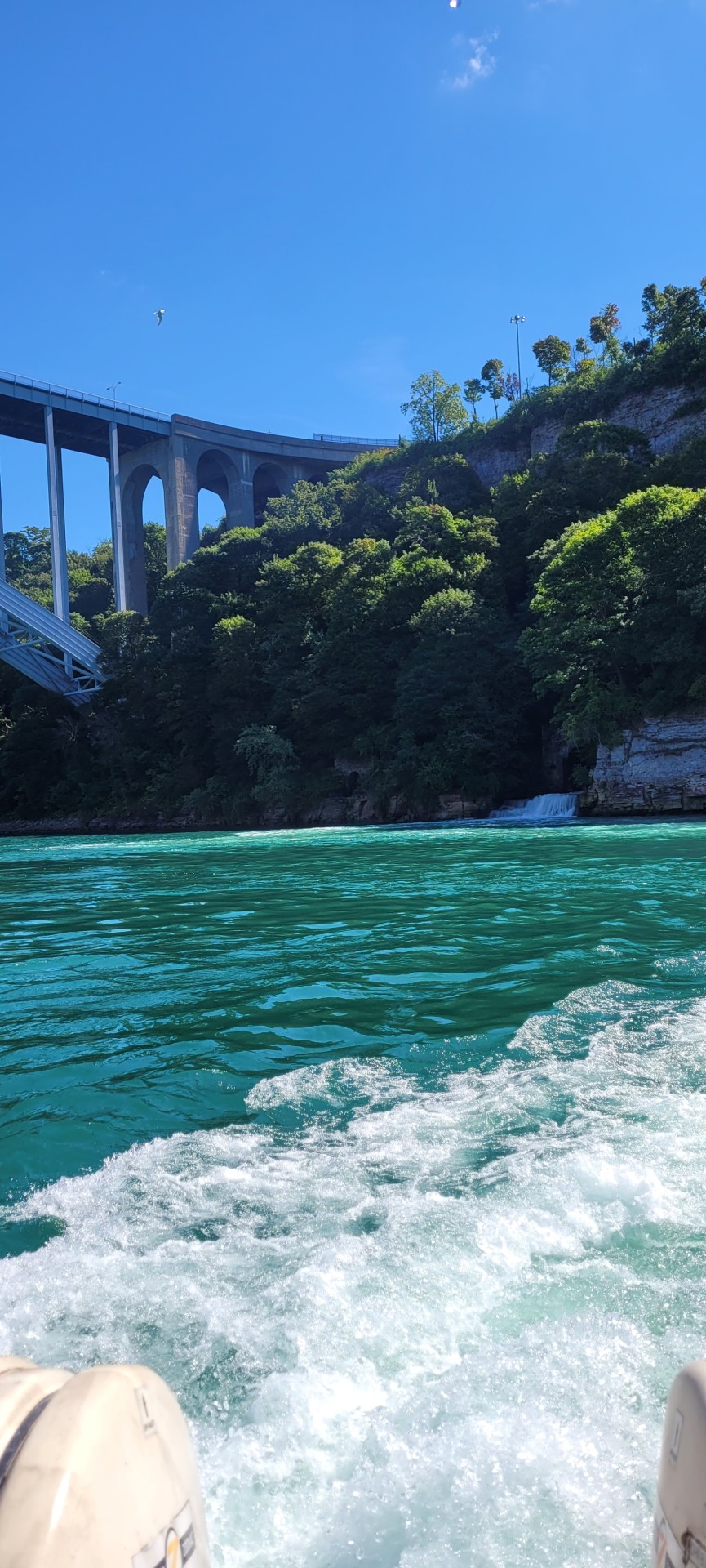
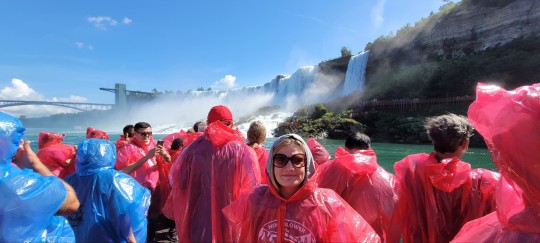
Trotz des Ponchos bin ich an einigen Körperstellen völlig durchnässt. Zum Glück scheint die Sonne. Wir haben eine gute Stunde Lunch-Freizeit in der Innenstadt, die praktisch nur aus einer potthässlichen Vergnügungsmeile besteht. Nach einem schnellen Burger setze ich mich in einen Park, blicke aus etwas Entfernung auf das Treiben an den Wasserfällen... und treffe noch einmal auf die zwei Frauen aus Hamburg, denen ich schon in Vancouver und Jasper begegnet war.
Auf dem Rückweg fahren wir noch an ein paar anderen Stellen entlang des Flusses vorbei, z.B. dem Niagara Whirlpool und der Floral Clock.
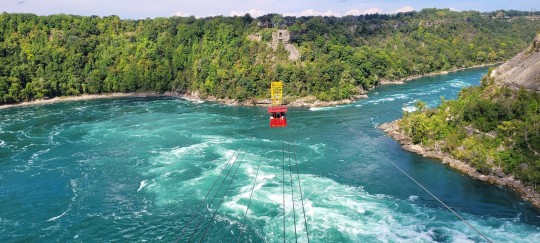

2 notes
·
View notes
Photo

INSTAGRAM: MARINA ROCKS ALEXANDER WANG, OLIVIA ROSE THE LABEL & NIKE IN KYOTO
“So happy to be back in Japan!” Marina posted via the ‘gram on November 30th, 2018. She and Clean Bandit traveled all the way to Nagasaki and Kyoto to continue their promotional tour for their song “Baby”.

Marina wore a green-hued outfit by mixing up high end with designer.
Firstly, she rocked an Alexander Wang dark green rib-knitted crop sweater with mock neck detail, which she paired with the Nora floral jacquard high-waisted fold trousers by Olivia Rose the Label.

Her sneakers are the Nike Air Force I white leather low-top sneakers with lace-up top and perforated detail.
3 notes
·
View notes
Text

KOKIA in flashback - 2006
The year of 2006 is an exciting one for KOKIA. She has gone abroad to perform before, but now she makes it all the way to Europe for concerts in Paris, France and represents Japan at MIDEM 2006, the World Music Market, in Cannes. Her new album aigakikoeru ('listen for the love') even gets a French/European release in November, ahead of the Japanese release next year and with an exclusive track. It is not her first album this year; she has enough songs to compile her first best of-album, resulting in the release of Pearl and Jewel, collecting her best of songs and promotional videos respectively.
Although KOKIA has been creating music for games and (animated) series and movies since the beginning of her career, the start of 2006 puts the spotlight on her with the single Ai no melody/chouwa oto ('melody of love/sound of harmony'), the opening and ending song for the movie Origin: Spirits of the Past (Giniro no kami no Agito in Japanese). Especially Chouwa oto ~with reflection~ turns into a much-requested hit, with KOKIA still regularly performing this song almost 20 years later. It is a new version of Chouwa, the first song on her album trip trip from 2002, which incorporates KOKIA-go ('KOKIA-language') by reversing the syllables of the Japanese lyrics.
And last but most definitely not least, 2006 is the year KOKIA becomes independent. In May, she decides to start her own private office, anco&co, which she runs to this day, in order to more freely express herself as an artist rather than being tied to the Japanese music scene. Aigakikoeru is her first release after her independence.
She starts her 47 Stories concerts this year, intending to visit all 47 prefectures of Japan, although in the end doesn't manage to get to all 47.
◆ Lives and events ◆
January 5
Giniro no kami no Agito (Origin: Spirits of the past) New Year's special event (Kawasaki, CLUB CITTA)
January 21
KOKIA Live in France: Bonjour Paris Bonjour mon ami! ('Hello Paris, hello my friend!') (Paris, L’espace Saint Martin)
※ First performance in Paris
January 23
MIDEM 2006 JAPAN NIGHT (Cannes, HOTEL MAJESTIC)
【KOKIA album tour 2006 Thank u!】
February 9 - Aichi, Electric Lady Land
February 10 - Osaka, BIGCAT
February 17 - Tokyo, DUO MUSIC EXCHANGE
February 26
Song for Winter Lovers in FACTORY (Sapporo Factory Atrium)
June 14
KOKIA 2006 keep moving vol.1 (Roppongi STB139 Sweet Basil)
※ 2 performances in 1 day. First live after going independent. Monthly performances spanning half a year.
July 1
at! Music Live (Queen's Square Yokohama)
※ 2 performances in 1 day
July 14
Enoshima Live Party 2006 (Enoshima Yacht Harbor Terrace)
July 24
KOKIA 2006 keep moving vol.2 ~birthday party~ (Roppongi STB139 Sweet Basil)
July 29
MAKE a day 06 in TIVOLI (Okayama, Kurashiki Tivoli park, Plainen stage)
August 12
First Izumo Legends festival (Shimane prefecture, Izumo city, Hamayama park)
※ Performed as a surprise guest
August 16
KOKIA 2006 keep moving vol.3 ~my favorite songs~ (Roppongi STB139 Sweet Basil)
August 27
6th Yuukyuu no mori ('forest of eternity') Shirakami festival (Akita, Goshonodai Fureai Park)
September 10
KOKIA concert ~47 stories in Shimane~ (Big Heart Izumo)
September 21
KOKIA 2006 keep moving vol.4 ~chello ni idakarete ♪~ ('embraced by the cello') (Roppongi STB139 Sweet Basil)
September 23
Kunimi mountain base music festival '06 (Nagasaki, Kunimi forest park)
October 14
Barefoot Kugenuma '06 Barefoot Concert (Prefectural Shônan Kaigan park, Surf Village, beach in front of the water plaza (mizu no hiroba)
October 22
KOKIA 2006 keep moving vol.5 ~neoclassic~ (Roppongi STB139 Sweet Basil)
November 27
KOKIA 2006 keep moving vol.6 ~finale~ (Roppongi STB139 Sweet Basil)
December 2
YAMAHA Stadium Mini Live (Shizuoka, Yamaha Stadium)
※ A capella opening live (Amazing Grace) and mini live after the match
December 8
KOKIA 47 stories in concert in Fukui (Mikuni cultural Miraikan)
December 24
KOKIA 2006 Christmas Dinner concert ~1 nenkan no jibun no gohoubi ni~ ('a reward to oneself after a full year') (Tokyo, Hotel Grand Pacific Meridian Palais Royal)
◆ Releases ◆
January 1
Release of the single Ai no melody/Chouwa oto ~with reflection~ ('melody of love/sound of harmony') (Victor Entertainment)
※ Both songs were used in the theatrically released animated movie Giniro no kami no Agito (Origin: Spirits of the past) as the ending and opening theme respectively
February 1
Best of album Pearl ~The Best Collection~ (Victor Entertainment)
※ First best of album. First released in France and Spain on January 20 with an European version (Discmedi)
February 1
Release of the DVD jewel ~The Best Video Collection~ (Victor Entertainment)
※ First video release. Collection of best music clips.
November 29
Release of original album aigakikoeru (listen for the love) (Wasabi Records)
※ First album after independence. Release in France ahead of Japanese release.
◆ Other releases ◆
January 7
Release of Giniro no kami no Agito (Origin: Spirits of the past) original soundtrack (Victor Entertainment)
※ Recorded the opening theme chouwa oto ~with reflection~ ('sound of harmony') and the end theme Ai no melody ('melody of love')
January 18
Release of the Yuki Ootake album Nemuru Kujaku ('Sleeping peacock') (King Records)
※ Composed the song Tokai no hitsuji (‘sheep of the city’)
March 24
Release of the Shirakami mountain region image song collection Shirakami no shi ('Poems of Shirakami')
※ Recorded and sang Yuukyuu no mori ('Forest of eternity')
April 19
Release of Iruka wan no koibito (‘lovers of the dolphin bay’) original soundtrack (Rock Records)
※ Japanese version of the soundtrack of the popular Taiwanese drama.
The songs I catch a cold and shiroi yuki ('white snow') were used as background music in the drama. (Taiwanese version released on January 1, 2003.)
June 7
Release of compilation album THANK YOU!! (Victor Entertainment)
※ Victor version of the compilation album of the 39 (sankyuu ('thank you')) project by Fuji TV's Mezamashi TV ('wake-up TV').
Performed Kawaranai koto ~since 1976~ ('things that won't change')
June 7
Release of compilation album Arigatou THANK YOU (Ponyo Canyon)
※Ponyo Canyon version of the compilation album of the 39 (sankyuu ('thank you')) project by Fuji TV's Mezamashi TV ('wake-up TV').
Performed Arigatou... ('thank you...')
◆ Books ◆
August 30
Release of the piano score Arigatou... ('thank you...') (anco&co)
◆ Other ◆
April
Sang the commercial song for KOMATSU Ltd.
May 21
Started the company anco (independent)
July 14~
Sang the song Tatta hitotsu no hada e hen ('just one collection for your skin') for the POLA cosmetics APEX-i commercial
August
Shiawase no hanataba ('bouquet of happiness') is used as image song for the Red Feather Central Community Chest of Japan
October 2
Start of her internet radio program KOKIAyakkyoku ('musical medicine') (until March 20, 2012)
※ Live internet radio program held every first and third Tuesday of the month
4 notes
·
View notes
Photo


141009 Japan Hall Tour SW 2014 ‘I’m Your Boy’ in Nagasaki
6 notes
·
View notes
Text
I've been tagged by the lovely @norashelley to spell out my URL using song titles! Here goes:
Jailbreak (AC/DC, 1976)
Wee Wee Hours (Chuck Berry, 1955)
Crying for the Carolines (Ruth Etting, 1929)
Leave My Girl Alone (Stevie Ray Vaughan & Double Trouble, 1989)
Alexander's Ragtime Band (The Boswell Sisters, 1934)
Pretty Girl (Eric Clapton, 1983)
The Grand Tour (George Jones, 1974)
Ole Buttermilk Sky (Kay Kyser and His Orchestra, 1946)
Nagasaki (The Mills Brothers, 1934)
Classic rock/blues and 1920s-40s songs… Welcome to my two extremes in musical preference. :)
I tag @cozywonderheart, @picklesandolives, @ripnorm, @babybeatnik, and @crybabydear to try this, too. Have fun!
7 notes
·
View notes
Text
Hashima Island, Japan
Ghost Town 03
Population: 5,259 (1959) - 0 (2016)
Country: Japan
Years active: 1887-1974
Why Was It Abandoned?
Hashima Island was known for its undersea coal mines during the industrialisation of Japan in 1887.
In 1974, the mines were closed due to the depletion of coal and the use of petroleum in place of coal, which led to many coal mines shutting down across the country. The residents of the island left soon after, and Hashima Island remained abandoned for the following three decades.
In the 2000s, Hashima Island attracted tourists and gained interest because of its untouched historic ruins. This led to Hashima Island being open to tourists on April 22, 2009 and being protected/restored.
Island Life
Originally on Takashima island, an island that was not far from Hashima, the Fukahori family owned the property as feudal lords and took advantage of the profitable opportunities that coal on the island brought. Coal mining was the basis of the local economy and residents were only seen as workers on the island. Due to the increasing demand of coal in the Western continents such as the UK and US for their steam ships in the 1850′s, Thomas B. Glover brought British equipment to the island coal reserves around Nagasaki, which advanced technology and mining practices in 1869 and introduced a new age of coal mining. Because of the success and increase in foreign currency, Fukahori decided to expand on neighboring islands, which is how Hashima Island became a coal mining island.
Around 15.7 million tons of coal were mined and excavated between 1891 and 1974. Coal was used by many Japanese people to heat their homes. They called this “goheita” after the legend about a man who stumbled upon the use of coal by accident.
In 1916, Japan’s first large reinforced concrete building was built to home the workers of the mines. The material used to build the structures pedaled Japan into a new era of architecture. They used concrete as protection against typhoons.
Over the next 55 years, Hashima Island began to grow. Apartment blocks, schools, a hospital, town hall, community centre, clubhouse, cinema, communal bath, swimming pool, rooftop gardens, shops, and a pachinko parlour were built for the miners and their families who lived on the island.
The economy on Hashima Island can be best described as socialist. Housing, electricity, and water were all free for the workers as long as they contributed to public work and territory clean up. The residents of Hashima Island had to depend on the outer world for food, clothes, and other articles of commerce. Fresh water was also delivered to the island until 1957 when tubes connected Hashima Island with water reservoirs on the mainland. This was inconvenient for islanders because of the potential threat of storms preventing sailing to Hashima Island for more than a day.
Until 1963, Hashima Island was just mountains and rock. That was until the “green campaign”, where Hashima residents brought soil from the mainland to the island to create roof gardens where they could grow vegetables and flowers. This also temporarily brought more “life and energy” to the island to lessen its gloomy appearance.
During the 1930’s until the end of World War II, conscripted Koreans and Chinese prisoners of war were forced to work under brutal treatment at the Mitsubishi facility as forced labourers under Japanese wartime mobilization policies. Many labourers died on the island from underground accidents, exhaustion, and malnutrition.
Today Hashima Island attracts many locals from Japan to tour on the island. Hashima Island also eventually became a World Heritage center, but on the condition that the government acknowledges the history of Hashima’s forced labor of Koreans. This was agreed upon, but due to the understatements made about Hashima Island’s forced labor from the Japanese government and addressing it as “work” instead of “forced labor” and disregarding the islands history has made a lot of Koreans and Japanese citizens feel as though the government cares more about the country’s reputation rather than the events and impact it’s had on workers. This is also supported by the fact that the history of Hashima Island’s forced labor is not taught in Japanese schools, which leaves many Japanese citizens unaware of the island’s history and cruelty to conscripted Koreans and war prisoners.
Victims of forced labor have described their experiences on Hashima Island as “a living hell”. Victims mention of how they were forced to work 12 hours a day in the mines while suffering from hunger.
The Nagaski Peace Museum, established in 1995, was created by Japanese citizens to publicize the truth about Japan’s history and demand compensation and apology to the foreign victims of Japan during World War II.
Pop Culture / Media Representation
Hashima, Japan documentary (2002)
History Channel’s Life After People (2009)
James Bond Film, Skyfall (2012)
live action Japanese films for Attack on Titan (2015)
Thai horror film Hashima Project (2013)
South Korean World War II film “Battleship Island” (2017)
Sources
Wikipedia
Why All The Islanders Left Hashima
The Truth About Hashima
2 notes
·
View notes
Photo
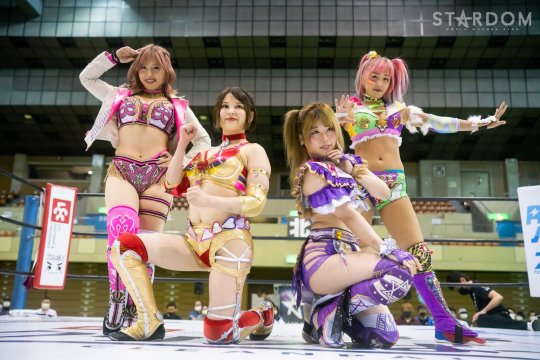
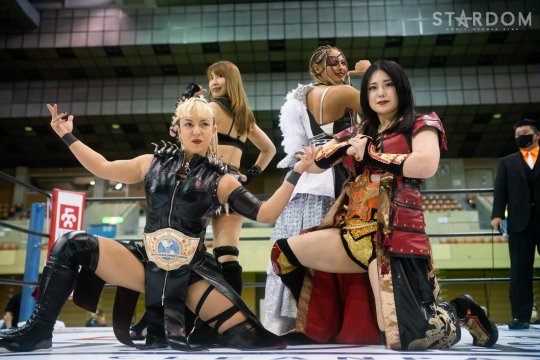
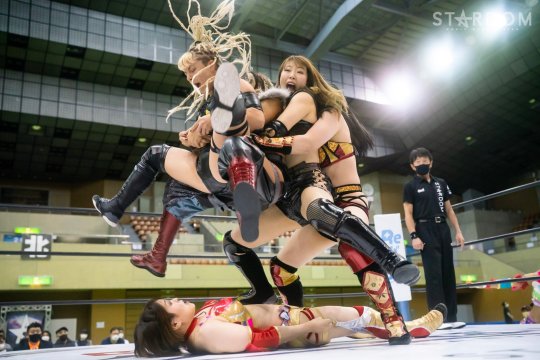
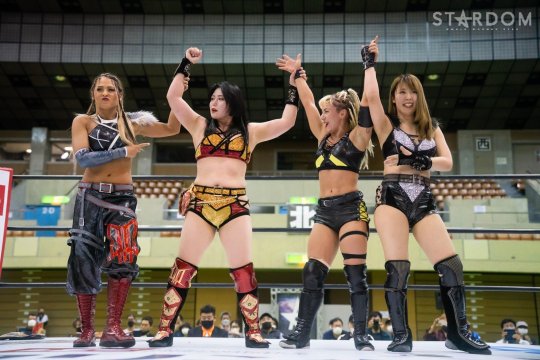
STARDOM Golden Week Fight Tour
May 3 Nagasaki
◆DDM vs Cosmic Angels
Giulia, Thekla, Maika & Mai Sakurai defeated Tam Nakano, Mina Shirakawa, Unagi Sayaka & Waka Tsukiyama. Maika pinned Waka after the Enka Otoshi.
#joshi puroresu#stardom#donna del mondo#cosmic angels#giulia#thekla#maika#mai sakurai#tam nakano#mina shirakawa#unagi sayaka#waka tsukiyama#golden week fight tour 2022
13 notes
·
View notes